 |
||
|
||
| ||
By Maxim Liadov
When Creative replaced the SoundBlaster Live!/Live!5.1 sound card family with the SoundBlaster Audigy they decided it was high time to refresh their 5.1 acoustic system as well. But while it is still easy to improve sound cards (24-bit records playback, 4 times increase in the chip's power, an integrated IEEE1394 controller, new DirectSound3D extensions - EAX ADVANCED HD), in the sphere of computer speakers it is a problem to find a new stimulus for attraction of users. Usually speakers become almost the last thing to think of for a user buying a PC. Only after a certain time he or she throw out such sound imitators and get something more expensive. If his or her computer has a DVD drive the user might consider a 5.1 acoustic system as functions of a home DVD player can be implemented by a computer. In this case you must know whether you are going to watch movies alone or with your friends displaying an image on a TV screen. In the latter case you'd better take an inexpensive PC-based 5.1 acoustic system (e.g., F&D IHOO 5.1, Jazz Speakers J-9906, SVEN 988). But as a rule, many do not feel any desire to set up 12 sizeable speakers around the room and a bundle of cables. That is why miniature computer speakers are very popular today. It is not simple to find an appropriate multimedia 5.1 acoustic system. Not everybody can afford speakers from such companies as Creative and VideoLogic (DigiTheatre and DigiTheatre DTS). Asian companies - Jazz (ROCCO 5.1), Kinyo (R-565 and D-565), Genius (SW-5.1 Surround) - do not produce high-quality sounded systems though they offer various designs and color solutions. Or rather, it is difficult to improve quality at the same sum of money, and it is unnecessary as the demand in this sphere depends on the price and appearance. Acoustic systems from Creative produced by its subdivision Cambridge SoundWorks look quite attractive: the price is not too high and the components of speakers and amplifiers are of high quality. The latest 5.1 acoustic systems from Creative were DTT2200 and DTT3500 models (DTT stands for DeskTop Theater). The DTT3500 is more than twice dearer than the 2200 as the former has a more expensive separate amplifying unit with the integrated Dolby Digital decoder, a remote control and floor stands for rear satellites. However, recently the old models were replaced by an absolutely new 5.1 acoustic system: the Cambridge SoundWorks DeskTop Theatre 5.1 2200 (DTT2200) was edged out by the Creative Inspire 5.1 5300, and the Cambridge SoundWorks DeskTop Theatre 5.1 3500 (DTT3500) was replaced with the Creative Inspire 5.1 Digital 5700 (Inspire 5700). The latter model is equipped with an integrated DD/DTS decoder! And just a few weeks after the press-release we managed to get this model. Apart from advertising stuff such as optimization of speakers for the EAX technology Creative promises redesigned satellites, a new subwoofer with the Creative SLAM technology (Symmetrically Loaded Acoustic Module) and DTS support in the decoder (apart from Dolby Pro Logic and DD5.1). DTT 3500 and Inspire 5700The DTT 3500 and Inspire 5700 systems have the same "mission" and similar characteristics. Each satellite is 7 W RMS, the central speaker is 21 W RMS and the subwoofer is 30 W RMS. As you know, power does not determine loudness of speakers and depends on THD when measured. That is why when choosing speakers do not compare their characteristics but listen to them. Let's take a look at the dimensions and appearance of the speakers.  DTT3500  Inspire 5700 Both systems contain 5 satellites, a subwoofer, a decoding and amplifying unit and a remote control. Let me start examining the Inspire 5700 with the satellites. They look more austere than the DTT3500.   Satellite of the Inspire 5700 (with and without a grill) The speakers are demountable. The plastic is 3 mm thick. The space inside is filled with sheet wadding by one third to damp mid-range sound waves coming from the rear side of the wide-band speaker. The latter is magnetic shielded. The magnet is marked with the CSW's label (Cambridge SoundWorks); its power is 10 W. The speaker looks identical to the one in the satellite of the DTT3500. The central speaker remained the same as compared with the DTT3500.   Central speaker of the Inspire 5700 (with and without a grill) The central speaker has a larger diffusor then the others satellites (the photos have the same scale) and looks very similar to its brother of the previous system.  Subwoofer of the Inspire 5700 The subwoofer has a cubic form. The low-frequency speaker is huge.  Subwoofer of the Inspire 5700 without a grill The DTT3500, as a top model in the Creative's acoustic line for almost a year, is equipped with stands for rear satellites, and removable skins and a stand for the decoder. These components are optional for the Inspire 5700.  Accessories for the Inspire 5700 I'm very pleased that Creative equips its acoustic sets so carefully starting from various cables to screws for mounting to the wall. The stands for rear satellites in the DTT3500 are really impressive.  Satellite on a stand (DTT3500) ConnectionThe first computer with the SoundBlaster Live! 5.1 sound card was connected to the DTT3500. The second with the Audigy onboard was connected to the Inspire 5700. On the photo you can see a subwoofer of the Inspire 5700 in the center, Event 20/20 bas active studio direct field monitors are on each side (are not included in the Creative speaker sets), 17" CRT Iiama and LG monitors and Mitsumi Ergo Classic keyboard (just to give you an idea of dimensions).  Inspire 5700 (on the left) and DTT3500 (on the right) Creative's cards can be connected in a digital mode by a special 3-channel (4-pin) cable with a Digital DIN connector. One end of this cable should be connected to the Digital Out of a sound card, the other - to the Digital DIN of the decoder. The sound card, thus, starts working in the Digital Output Only mode, and the decoder - in the Digital DIN Multichannel mode. It makes possible to transfer 6-channel information when reproducing music and games in the PCM 16 bit 48 kHz format without encoding by compression algorithms with losses (DD5.1/DTS). It means that 3 cables and ground transfer 6 PCM streams, at 48 kHz for the Live! 5.1 and at 44.1, 48 or 96 kHz for the Audigy. I'd recommend you to take 48 kHz though both the DTT 3500 and the 5700 recognize an input signal format up to 24 bit 96 kHz. There are three possible variants for sound decoding in the DolbyDigital 5.1 format: with a program DVD player, with card's drivers (for example, for a stream from a hardware MPEG-2 decoder Creative Dxr3 (Holliwood+)) or with an external decoder in amplifier/decoder unit. The DTS format in the Live!5.1 + DTT3500 system can be decoded with CyberLink PowerDVD XP 4.0 or InterVideo WinDVD2000 3 DTS edition program players. The decoded 6 channels will go to high-quality 24/96 DACs of the decoder in a digital form! That is, without quality losses. In case of the Audigy + Inspire 5700 an internal hardware chip in the amplifying and decoding unit of the Inspire 5700 can be used as a decoder.  Front panel of the decoder of the Inspire 5700 Like in the DTT3500, the decoder of the Inspire 5700 has separate volume controls for a subwoofer, central and rear speakers. The regulator of the overall volume is motorized, it turns synchronously with a level when controlled with a remote control.  Switches for inputs and operation modes Switches for inputs and operation modes can be also found on the remote control. With the Effect button you can choose a mode of an effect-processor. The CMSS Movie serves for reproduction of movies with a stereo sound on all 5.1 speakers. The CMSS (Creative Multi Speaker Surround) is a proprietary technology of Creative for virtualization of stereo sound through multi speaker configurations (4 or 5.1). It is identical to the Dolby Pro Logic.  DTT3500 decoder This option works quite good. Reproduction of music in the CMSS Music mode is excellent: a more powerful central channel extends the frequency range and sound dynamics of other satellites. The subwoofer plays low frequencies. The Fourpoint/5.1 DIN is meant for constant reproduction of a signal applied to 4 analog or 6 digital channels. In this case you can use presets of a sound card. The type of a multichannel input can be chosen with the Analog button. The Digital/PCM Audio can help you choose one of three types of a digital-in: Optical, Coaxial, Digital DIN. It should be noted that the Dolby Pro Logic can be decoded both from a digital-in and from an analog-in, for what there is a button for Pro Logic forced decoding activation on the right side of the decoder. This option allows watching video cassettes with a Dolby Pro Logic soundtrack if you have a VHS with stereo sound support.  Rear panel of the decoder of the Inspire 5700 The rear panels of the decoders do not differ from each other. All the connectors are marked so that you make correct connections. "R" is a right speaker, "L" is a left one, "RS" is right surround, "LS" is, thus, left surround, "C" is center etc. "Coaxial" is for connection of some external source of a digital sound, for example, Holliwood+. "Optical" is meant for various minidisc devices. By the way, among the accessories you can find a plastic optical cable with standard (not minijack) connectors. For connection of the speakers there are quite good long copper multiple cords. The remote controls do not differ much.  Remote controls of the Inspire 5700 (on the left) and of the DTT 3500 (on the right) In my opinion, in the Inspire 5700 the buttons are more logical because in the 3500 the procedure of activation of the Digital DIN Multichannel mode is too complicated. It is necessary to turn on then turn off one Digital DIN LED, then turn on another LED also marked as Digital DIN. Subjective testsWe decided to listen to the system before measuring AFCs of the speakers, as the main tool of a music expert is his ears. On the other hand, a verbal description can never be complete, and impression greatly depends on the psychophysical state of an expert. MusicFor listening the music and estimation of the quality of reproduction we used different compositions, from jazz to pop. I should note that the DTT3500 and Inspire 5700 sound very similar, that is why what is said below concerns both systems. The sound was quite good for the system of this class. At the low volume the speakers create a uniform sound field around a listener. But it matters a lot how the speakers are positioned. Such small speakers are meant only for one user sitting in front of a computer. As to the rear speakers, you'd better put them on the stands instead of hanging on the wall. If you place place them on the table that the distance between rear speakers is to be as large as possible, and the front should be put deeper and directed at the listener. The central speaker should be put on the monitor (as we did it) or between a keyboard and the monitor. The central speaker, thus, has two stands: one raises up the axis of the speaker, the other lowers it. As usual, pop compositions with compressed sound and a narrow dynamic range sounded the best. For example, Destiny's Child ("Survivor" album). To test the bass depth we used a composition called "Stan" of Eminem which had a very low frequencies in bass part. We also used a classic thing with a breakbits and a low bass of Olive "You're Not Alone". Despite the different design both subwoofers played rather good almost equally. In some compositions a tones of the bass part was clear and easy to recognize, in others it was indistinct. It was a hard task to adjust a filter's cutoff frequency of a signal for the subwoofer on the Audigy sound card, and to use the Bass Redirection function for the best advantage. These options allow adjusting a signal distribution between a subwoofer and satellites (whose clearly audible low frequencies only start from 100 Hz and higher). MoviesIt was interesting that the decoding quality of the program DVD players supporting DD/DTS decoding (PowerDVD 4.0 XP, WinDVD2000 3.0 DTS edition) and hardware decoders integrated into amplifying units was different! The hardware solutions are really better. Althoung in both cases the signal was applied in a digital mode: in the first case it was transferred via a 4-pin cable in the '6 speakers' mode in the DVD player, in the second case - in the S/PDIF bypass mode. With the hardware solution we got a clear and distinct sound picture. To watch movies comfortably you should position correctly and adjust sound of all channels. In the Surround Mixer utility of the Live!5.1 and Audigy sound cards you can just indicate a listener's position relative to other speakers. It is quite comfortable to watch movies if you are alone. If you have an expensive audio system you might dislike it because the sound is somewhat flat and non-transparent. But if you have never dealt before with multichannel surround sound you will be really surprised and excited! GamesSound in games can be considered as a combined sound of movies and music. That is why it is difficult to find peculiarities. But I should mention once again that sound in multichannel games with DirectSound3D and EAX support together with Live!5.1 or Audigy with any of these systems is transferred only in a digital form and without losses in quality and multichanneling. If you connect other 5.1 acoutic sets with an ordinary decoder in a digital mode the multichannel sound will be available only in movies because it is impossible to transfer a 6-channel uncompressed data stream via a usual cable with a standard S/PDIF protocol (IEC-958 consumer part). In the part of data transferred it is limited by: 20 bit * 48 000 1/s * 2 = 1875 Kbit/s. In other hand, six uncompressed 16bit 48kHz PCM streams need 4500 Kbit/s. In closing I should say that among all PC-based 5.1 acoustic systems of this class that we tested the DTT3500 and Inspire 5700 can be compared only with the VideoLogic DigiTeatre DTS. But they are twice dearer (because of wooden double-band satellites and speakers from Audax (a subdivision of Harman International), and provide only stereo in games (!). Objective tests. AFCThe AFC was analyzed with the RMAA Acoustic Test Edition v 3.1 (more info is on the official site audio.rightmark.org). The measurements were carried out with a special omnidirectional measurement microphone Behringer ECM8000. It was plugged in mixer Behringer MX602A (for phantom power +48V and level adjusting) and then to the Egosys Waveterminal 2496 soundcard. Test signal was generated and also record by this soundcard with FR = 20 Hz - 20 kHz, -0.01/+0.07 dB. Connection wires are Proel (Italy) noiseless OFC microphone cables with gold-plated jacks. For testing a speaker the program used a special test signal which is very close to a musical one in characteristics. Then tested loopback with this signal on the measurement soundcard flat line appears. 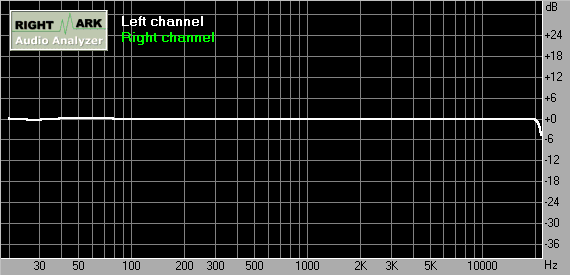 A transfer function for the measurement microphone is in the graphics below 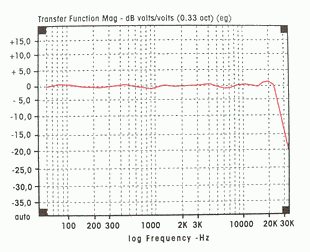 Amplitude-frequency characteristic (AFC) of an acoustic system is one of the necessary but not sufficient parameters of sound quality. An AFC shows linearity of a signal amplitude depend upon its frequency, and is plotted in a logarithmic scale on both axes, which corresponds to auditory sensation of a human being in a linear proportion. The most unpleasant AFC for us is that with a severely broken line. The ideal one will be an even horizontal line from 20-30 Hz to 18-20 kHz +/- 3 dB from the average. Such characteristic has for example an expansive studio monitors. So we tested Event 20/20 bas active studio direct field monitors (~ 950 USD).  And it is very close to FR graphics in its documentation  A speaker with a bad AFC can't deliver a frequency spectrum correctly. But in theory this becomes possible when an acoutic system with a better specified AFC is less suitable for a user than a speaker with a worse one; it depends on other parameters. For example, the former may have bad harmonic and intermodulation distortions, worse directional characteristics etc. And, sure, you shouldn't pay too much attention to the figures 20 Hz - 20 kHz in the speaker documantations. They are often given for unacceptable and fabricated flatness (e.g., +10/-40 dB) or for some subtle technique of measurements. Now let's take a look at the AFCs. Without grills on 5700 speakers they have almost equal AFCs. The grill give some smoothing in HF area. 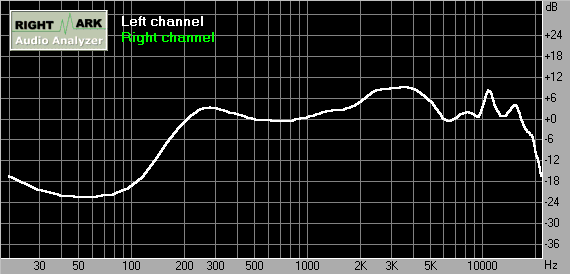 AFC of the satellite with angle of 0 degree 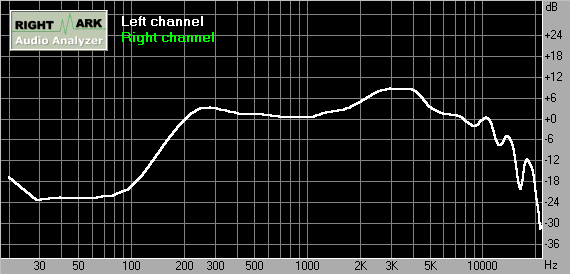 AFC of the satellite with angle of 30 degree 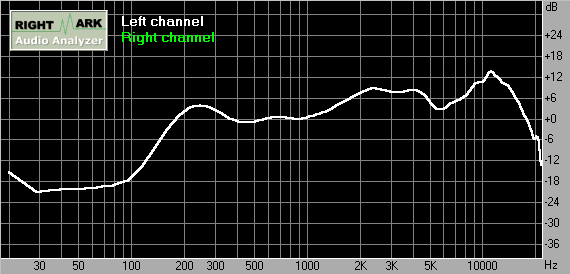 AFC of the central speaker with angle of 0 degree 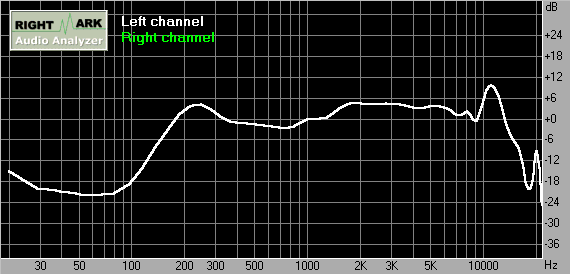 AFC of the central speaker with angle of 30 degree In all cases power of HF is too depended on speakers direction. That is why you need to direct both front satellites to you ears. I'd also advice you to set the Music mode in the decoder as it can improve sound volume and by adding a central speaker.  AFC of the subwoofer of the DTT 3500  AFC of the subwoofer of the Inspire 5700 It is really a baffling problem to measure an AFC of a subwoofer just as it is, especially with a "resonance chamber" acoustic scheme as it depends on acoustical characteristics of the room. This is exactly what we have with the subwoofer of the DTT 3500: it's not simple to find the right position, but if you have found it you won't be disappointed with the bass depth. The subwoofer from the Inspire 5700 is different. The "closed box" scheme and a lack of a phase-inverter make possible to place it almost wherever you want, but beware of parasitic resonance with furniture. The results show that in the second case a more wide-band and linear scheme is less impressive. But it also depends on the wide-band test signal. Sure, we could have given a swept sine but such results are less correct. The measurements prove that the subwoofer of the DTT3500 catches deeper basses. A slump in the upper part of the LF range of the Inspire 5700 is caused by complexity to reach the upper bass in diffusors with larger diameters because of irregular oscillations of their surface at higher frequencies. On the other hand, the DTT3500 is a resonance system which has a phase error and a good output only in a narrow frequency range. But we heard nothing of the kind. Well, there is a small gap in the AFC (near 150 Hz) when the subwoofer can't be heard any more and the satellites are still not heard too much. But you will hardly notice it by our ear.  However, Creative mentions other advantages of its subwoofer, namely improved pulse characteristics ("bass that is fast, tight and punchy"). It is fair for a closed case. With not too powerful amplifies the manufacturer had to make a very soft corrugation and a diffusor with a big working stroke to increase sensitivity for the closed scheme. A more flexible corrugation means a faster response and a longer oscillating process. Deviation and lag of a signal can be considered as additional amplitude and phase errors. It is resulted in indistinct and fuzzy bass. In my opinion, it is caused by the fact that the developers used polypropylene. Usage of latex-based materials which are used in the Hi-Fi world could have improved it much. But it is too captious criticism for an acoutic system of such class. I can't say that one subwoofer is better than the other: both have advantages and disadvantages. In general, the subwoofer works in the specified range loudly and distinctly but the developers could have made it much better. ConclusionIn their price range ($250-300) and in their class of small dimensions the 5.1 acoustic system with an external DD decoder CSW DeskTop Theater 3500 and the 5.1 acoustic system with an external DD/DTS decoder Creative Inspire 5700 are one of the best 5.1 sets at the moment. Highs:
Lows:
Write a comment below. No registration needed!
|
Platform · Video · Multimedia · Mobile · Other || About us & Privacy policy · Twitter · Facebook Copyright © Byrds Research & Publishing, Ltd., 1997–2011. All rights reserved. |